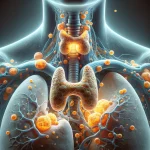Hypoparathyroidism is a condition where the body doesn’t make enough of a hormone needed to keep calcium levels normal, which can cause muscle cramps, weakness, and other health issues.
Causes:- Surgery: Damage to the parathyroid glands during neck or thyroid surgery is the most common cause.
- Autoimmune diseases: In some cases, the immune system attacks the parathyroid glands, causing them to stop functioning properly.
- Genetic factors: Some people are born with underdeveloped or absent parathyroid glands due to genetic conditions.
- Radiation treatment: Radiation therapy for cancers in the neck or head area may affect the parathyroid glands.
- Individuals who have had neck surgery: Those who have undergone thyroid or other neck surgeries are at higher risk, as the parathyroid glands can be accidentally damaged.
- People with autoimmune conditions: Conditions such as Addison’s disease or type 1 diabetes increase the risk of autoimmune hypoparathyroidism.
- Genetic conditions: People with a family history of hypoparathyroidism or genetic disorders affecting the parathyroid glands are more susceptible.

